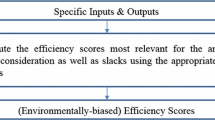Abstract
The banking industry in Canada is essentially an oligopoly with five large participants controlling about 90% of the market. To evaluate the industry's performance over time, we need to deal with the problem of a small number of DMU's compared to the number of relevant inputs and outputs. To overcome this problem we use data envelopment analysis (DEA) window analysis, whereby efficiency scores for the 20 year period 1981–2000 are obtained. To measure productivity changes over time, Malmquist indices can be calculated from DEA scores. Using DEA window analysis scores, however, raise the question of how to define the “same period frontier” in a DEA window analysis. We show that for both the adjacent and the base period Malmquist index and for all suggested definitions of same period frontier, the standard decomposition into frontier shift and catching up effects gives inappropriate results when Malmquist indices are based on DEA window analysis scores.
Similar content being viewed by others
References
Ali, A. A. and L. M. Seiford. (1993). “The Mathematical Approach to Efficiency Analysis.” In H. Fried, C. A. K. Lovell and S. Schmidt (eds.), The Measurement of Productive Efficiency: Techniques and Applications. Oxford University Press.
Althin, R. (2001). “Measurement of Productivity Changes: Two Malmquist Index Approaches.” Journal of Productivity Analysis 16, 107–128.
Banker, R. D. and R. M. Thrall. (1992). “Estimation of Returns to Scale using Data Envelopment Analysis.” European Journal of Operational Research 62, 74–84.
Berg, S. A., F. R. Førsund and E. S. Jansen. (1992). “Malmquist Indices of Productivity Growth during the Deregulation of Norwegian Banking, 1980–89.” Scandinavian Journal of Economics (Supplement), 211–228.
Berger, A. N. and D. B. Humphrey. (1997). “Efficiency of Financial Institutions: International Survey and Directions for Future Research.” European Journal of Operational Research 98, 175–212.
Charnes, A., C. T. Clark, W. W. Cooper and B. Golany. (1985). “A Developmental Study of Data Envelopment Analysis in Measuring the Efficiency of Maintenance Units in the U.S. Air Forces.” Annals of Operations Research 2, 95–112.
Charnes, A., W. W. Cooper, A. Y. Lewin and L. M. Seiford (eds.) (1994). Data Envelopment Analysis: Theory, Methodology and Applications. Kluwer Academic Publishers.
Charnes, A., W. W. Cooper and L. M. Seiford. (1994). “Extension to DEA Models.” In A. Charnes, W. W. Cooper, A. Y. Lewin and L. M. Seiford (eds.), Data Envelopment Analysis: Theory, Methodology and Applications. Kluwer Academic Publishers.
Charnes, A., W. W. Cooper and E. Rhodes. (1978). “Measuring the Efficiency of Decision Making Units.” European Journal of Operational Research 2(6), 429–444.
Cook, W. D. and M. Hababou. (2001). “Sales Performance Measurement in Bank Branches.” Omega 29(4), 299–307.
Cook, W. D., M. Hababou and H. J. H. Tuenter. (2000). “Multicomponent Efficiency Measurement and Shared Inputs in Data Envelopment Analysis: An Application to Sales and Service Performance in Bank Branches.” Journal of Productivity Analysis 14(3), 209–224.
Cooper, W. W., L. M. Seiford and K. Tone. (2000). Data Envelopment Analysis. Kluwer Academic Publishers.
Färe, R., S. Grosskopf, B. Lindgren and P. Roos. (1994). “Productivity Developments in Swedish Hospitals. A Malmquist Output Index Approach.” In A. Charnes, W. W. Cooper, A. Y. Lewin and L. M. Seiford (eds.), Data Envelopment Analysis: Theory, Methodology and Applications. Kluwer Academic Publishers.
Fischer, I. (1922). The Making of Index Numbers: A Study of Their Varieties, Tests, and Reliability. Boston: Houghton Mifflin Company.
Freedman, C. (1998). The Canadian Banking System. Technical Report No. 81, Bank of Canada, Ottawa.
Førsund, F. R. (1993). “Productivity Growth in Norwegian Ferries.” In H. Fried, C. A. K. Lovell and S. Schmidt (eds.), The Measurement of Productive Efficiency: Techniques and Applications. Oxford University Press.
Goto, M. and M. Tsutsui. (1998). “Comparison of Productive and Cost Efficiencies Among Japanese and U.S. Electric Utilities.” OMEGA: International Journal of Management Science 26(2), 177–194.
Grifell-Tatje, E. and C. A. K. Lovell. (1995). “A Note on the Malmquist Productivity Index.” Economics Letters 47, 169–175.
Malmquist, S. (1953). “Index Numbers and Indifference Surfaces.” Trabajos de Estadistica 4, 209–242.
Parkan, C. (1987). “Measuring the Efficiency of Service Operations: An Application to Bank Branches.” Engineering Costs and Production Economics 12, 237–242.
Richardson Greenshields. (1995). The Bank Examiner. Equity Research Report, Sept. 1995.
Richardson Greenshields. (1995). Financial Services Monthly Monitor. Equity Research Report, Oct. 1995.
Schaffnit, C., D. Rosen and J. C. Paradi. (1997). “Best Practice Analysis of Bank Branches: An Application of DEA in a Large Canadian Bank.” European Journal of Operational Research 98, 269–289.
Sueyoshi, T. and S. Aoki. (2001). “A Use of Nonparametric Statistic for DEA Frontier Shift: The Kruskal and Wallis Rank Test.” OMEGA: International Journal of Management Science 29, 1–18.
Thompson, R., F. Singleton, R. Thrall and B. Smith. (1986). “Comparative Site Evaluations for Locating a High-Energy Physics Lab in Texas.” Interfaces 16(6), 35–49.
Thore, S., G. Kozmetsky and F. Phillips. (1994). “DEA of Financial Statements Data: The U.S. Computer Industry.” The Journal of Productivity Analysis 5, 229–248.
Tulkens, H. and P. Vanden Eeckaut. (1995). “Non-Parametric Efficiency, Progress and Regress Measures for Panel Data: Methodological Aspects.” European Journal of Operational Research 80, 474–499.
Westergaard, H. (1890). Die Grundzüge der Theorie der Statistik. Jena: Gustav Fischer.
Wood Gundy Inc. (1995). The Canadian Chartered Banks, Investment Research Report, Sept. 1995.
Yue, P. (1992). “Data Envelopment Analysis and Commercial Bank Performance: A Primer with Applications to Missouri Banks.” Federal Reserve Bank of St. Louis Review, Vol. 74–1.
Author information
Authors and Affiliations
Rights and permissions
About this article
Cite this article
Asmild, M., Paradi, J.C., Aggarwall, V. et al. Combining DEA Window Analysis with the Malmquist Index Approach in a Study of the Canadian Banking Industry. Journal of Productivity Analysis 21, 67–89 (2004). https://doi.org/10.1023/B:PROD.0000012453.91326.ec
Issue Date:
DOI: https://doi.org/10.1023/B:PROD.0000012453.91326.ec




